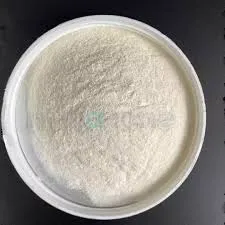
Nov . 21, 2024 20:23 Back to list
methyl hydroxyethyl cellulose mhec
Understanding Methyl Hydroxyethyl Cellulose (MHEC) Properties, Applications, and Benefits
Methyl Hydroxyethyl Cellulose (MHEC) is a cellulose ether that has gained considerable attention in various industrial applications due to its unique properties. MHEC is synthesized by the etherification of cellulose with methyl and hydroxyethyl groups, which enhances its solubility in water and imparts specific functional characteristics. This article explores the properties, applications, and benefits of MHEC, shedding light on its significance in modern industries.
Properties of MHEC
MHEC is characterized by its excellent water retention, thickening, and film-forming abilities. It is a white, odorless powder that is soluble in water, forming a clear, viscous solution. The degree of substitution influences its properties, such as viscosity and solubility. MHEC exhibits pseudoplastic behavior, meaning its viscosity decreases with increasing shear rate, making it an ideal thickener for various formulations. Additionally, it is stable across a wide range of pH levels, making it suitable for different applications.
One of the standout features of MHEC is its ability to retain moisture. This property is critical in formulations that require prolonged hydration, such as in construction materials and personal care products. The molecular structure of MHEC allows it to form hydrogen bonds with water molecules, enhancing the water-holding capacity significantly.
Applications of MHEC
MHEC is widely utilized in diverse sectors, including construction, pharmaceuticals, food, and cosmetics.
1. Construction In the construction industry, MHEC serves as a vital additive in tile adhesives, cement-based products, and stuccos. Its water retention properties ensure that the adhesive remains workable for extended periods, allowing for better adhesion and reduced cracking during the curing process. The improved consistency and performance make MHEC a preferred choice for construction professionals.
methyl hydroxyethyl cellulose mhec

2. Pharmaceuticals MHEC plays a crucial role in the pharmaceutical sector, primarily as a binder and thickening agent in various formulations. It assists in controlling the release of active pharmaceutical ingredients (APIs), ensuring a sustained release profile that enhances therapeutic effectiveness. Additionally, MHEC's biocompatibility makes it safe for use in drugs and other healthcare products.
3. Food Industry MHEC is recognized as a food additive in various products, where it acts as a stabilizer, thickener, and emulsifier. Its ability to modify the texture and viscosity of food products is invaluable in sauces, dressings, and dairy applications. Moreover, it helps to improve the mouthfeel and overall sensory experience of food items.
4. Cosmetics and Personal Care In cosmetics, MHEC is widely used in creams, lotions, and gels. Its thickening properties enhance product viscosity, improving spreadability and stability. MHEC also contributes to moisture retention in skincare products, providing an excellent moisturizing effect that is highly sought after in beauty formulations.
Benefits of MHEC
The advantages of using MHEC are numerous. Its ability to improve the texture and consistency of products enhances user experience and product performance. The water-retention capacity ensures that materials remain workable and effective over time, while its stable properties lend reliability across various environmental conditions.
Furthermore, MHEC is non-toxic and biodegradable, making it an environmentally friendly option for many applications. As industries continue to prioritize sustainability and eco-friendliness, MHEC stands out as a versatile ingredient that aligns with these goals.
Conclusion
Methyl Hydroxyethyl Cellulose (MHEC) is a multifunctional polymer that has become indispensable across various industries. With its unique properties, including effective thickening, excellent water retention, and versatility, MHEC plays a vital role in enhancing product quality and performance. As research and development continue to evolve, the potential applications and benefits of MHEC are likely to expand, reinforcing its significance in modern formulations and practices. Whether in construction, pharmaceuticals, food, or cosmetics, MHEC proves to be a valuable ingredient, contributing to innovation and effectiveness in numerous products.
-
Versatile Hpmc Uses in Different Industries
NewsJun.19,2025
-
Redispersible Powder's Role in Enhancing Durability of Construction Products
NewsJun.19,2025
-
Hydroxyethyl Cellulose Applications Driving Green Industrial Processes
NewsJun.19,2025
-
Exploring Different Redispersible Polymer Powder
NewsJun.19,2025
-
Choosing the Right Mortar Bonding Agent
NewsJun.19,2025
-
Applications and Significance of China Hpmc in Modern Industries
NewsJun.19,2025







